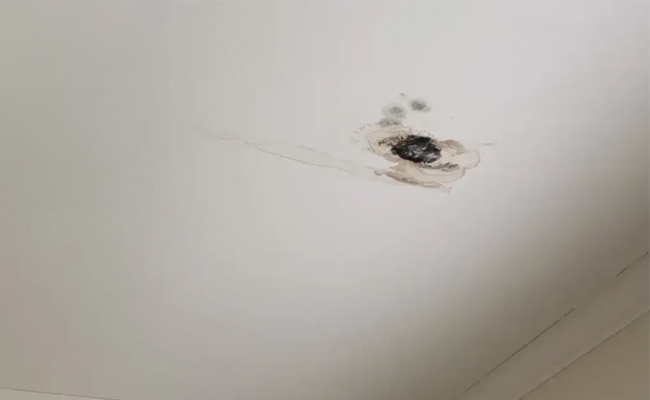Water ceiling damage is a silent threat that can sneak up on you, often unnoticed until it's too late. Beyond the unsightly stains and peeling paint, this issue can compromise your home's structural integrity and pose health risks. Promptly understanding and addressing water damage isn't just about aesthetics — it's a crucial step in safeguarding your home and your family's well-being.
7 Common Causes of Water Ceiling Damage
Water damage on ceilings can be a real headache for homeowners. Understanding the common causes can help you prevent these issues before they become major problems. Here are some of the most common causes of water damage on ceilings:
- Leaking Roof: Damaged or missing shingles, as well as improperly sealed flashing, can allow water to seep into your home. Over time, this can lead to extensive ceiling damage and even structural issues.
- Plumbing Leaks or Burst Pipes: Pipes running through the ceiling or in the attic can develop leaks, causing water to drip down and damage the ceiling. Whether due to freezing temperatures, age, or water pressure, burst pipes can release large amounts of water into your ceilings, causing immediate and severe damage.
- Condensation: Poor ventilation or high indoor humidity levels can lead to condensation buildup, especially in bathrooms and kitchens. Over time, this moisture can penetrate the ceiling material, causing it to weaken and degrade.
- Overflowing Gutters: Clogged or overflowing gutters can cause water to spill over and saturate the exterior walls, leading to ceiling leaks.
- HVAC Issues: Air conditioning units or heating systems that are not properly maintained can result in condensation or leaks that damage ceilings.
- Appliance Leaks: Water heaters, washing machines, and dishwashers can develop leaks that can damage ceilings if they are located above living spaces.
- Natural Disasters: Events like floods or heavy storms can cause roof damage or lead to water infiltration through windows and doors.
7 Signs of Water Ceiling Damage
Spotting water damage on your ceiling early on can save you a lot of hassle and money in the long run. Knowing the signs to look out for can help you identify issues and address them before they worsen.
Here are the key signs of water damage on your ceiling:
- Water Stains: Yellow or brownish stains on the ceiling are often the first visible signs of water damage. These stains may spread over time if the leak continues.
- Peeling Paint or Wallpaper: Moisture from water damage can cause paint or wallpaper to bubble, crack, or peel away from the ceiling.
- Sagging Ceiling: If you notice your ceiling starting to sag or droop, it's a clear indication that water has accumulated and weakened the ceiling material.
- Mold or Mildew Growth: Water damage often leads to the growth of mold or mildew on the ceiling. These can appear as dark spots or patches and may have a musty odor.
- Dripping Water: If you see water dripping from the ceiling, it's a sure sign that there's a leak that needs immediate attention.
- Soft Spots: Gently press on the ceiling in different areas. If you feel soft or damp spots, it's likely that those areas are water damaged.
- Cracks or Blisters: Water damage can cause the ceiling to develop cracks or blisters, which can compromise its structural integrity.
If you notice any of these signs, it's crucial to act quickly. Ignoring water damage can lead to more extensive damage, mold growth, and even structural issues. It's best to consult with a professional to identify the source of the leak and make necessary repairs as soon as possible.
PRO TIP! Conduct regular ceiling inspections, especially after heavy rains or plumbing work, to catch these signs early.



Potential Risks and Consequences of Leaving Ceiling Water Damage Alone
Ignoring water damage on your ceiling might seem tempting due to the effort and expense of repairs, but the risks and consequences of neglecting these issues can be significant. Let's delve into what could happen if you don't address water damage promptly:
- Structural Damage: Over time, water damage can weaken the structure of your ceiling. This can lead to sagging, cracks, or even partial collapse if the damage is severe enough.
- Mold and Mildew Growth: Moisture from water damage creates a perfect breeding ground for mold and mildew. These fungi not only damage your ceiling further but can also pose serious health risks, especially for those with respiratory issues.
- Decreased Property Value: Unrepaired water damage can detract from your home's aesthetic appeal and overall value. Potential buyers may be wary of purchasing a home with visible water damage, leading to a lower selling price.
- Electrical Hazards: Water and electricity don't mix well. If water reaches electrical wiring or fixtures in your ceiling, it can create a fire risk or lead to electrical shock.
- Increased Repair Costs: The longer you wait to address water damage, the worse it will get. This can result in higher repair costs as the damage spreads and becomes more extensive.
- Health Risks: In addition to mold and mildew, water damage can also attract pests like rodents and insects. These pests can carry diseases and further compromise your home's hygiene.
- Aesthetic Issues: Even if the damage doesn't pose immediate risks to your home's structure or safety, water stains, peeling paint, and sagging ceilings can be unsightly and detract from your home's appearance.
It's always best to address water damage as soon as you notice it to mitigate these risks and ensure the safety and integrity of your home.
How to Prevent Water Damage on Your Ceiling
Prevention is always better than cure when it comes to water damage on your ceiling. Taking proactive measures can help you avoid costly repairs and headaches down the line. Here's how you can prevent water damage on your ceiling:
- Regular Roof Maintenance: Inspect your roof at least once a year for damaged or missing shingles, cracks, or other signs of wear and tear. Repairing these issues promptly can prevent water from seeping through.
- Check for Plumbing Leaks: Regularly inspect pipes, faucets, and other plumbing fixtures for leaks. Look for signs of water stains, mold, or moisture around these areas.
- Maintain Gutters and Downspouts: Clean out gutters and downspouts regularly to prevent clogs and ensure water flows away from your home's foundation. Consider installing gutter guards to reduce maintenance.
- Proper Ventilation: Ensure that your bathrooms, kitchens, and laundry rooms are well-ventilated to reduce humidity and condensation. Use exhaust fans or open windows when cooking, showering, or doing laundry.
- Monitor Appliances: Check your water heater, washing machine, dishwasher, and other appliances regularly for signs of leaks or malfunction. Replace hoses and connections as needed.
- Seal Windows and Doors: Inspect and repair any gaps or cracks around windows and doors to prevent water infiltration during heavy rain or storms.
- Install a Leak Detection System: Consider installing a leak detection system that can alert you to any water leaks or moisture buildup in your home, allowing you to act before significant damage occurs.
- Insulate Pipes: Insulating pipes in unheated areas like the attic or crawl space can prevent them from freezing and bursting during cold weather, which can lead to water damage.
- Act Quickly: If you notice any signs of potential water damage, such as stains or moisture spots on the ceiling, address them immediately. Identify the source of the leak and make necessary repairs as soon as possible to prevent further damage.
By following these preventive measures, you can significantly reduce the risk of water damage on your ceiling and keep your home safe, dry, and in good condition. Regular maintenance and vigilance are key to protecting your home from water-related issues.
PRO TIP! Create a maintenance schedule for your home and set reminders for regular inspections and maintenance tasks to stay ahead of potential problems.

Immediate Actions to Take if You Notice Water Damage on Your Ceiling
If you notice water damage on your ceiling, taking immediate action is crucial to minimize further damage and address the issue effectively. The steps you should take can vary depending on the severity of the damage, but here's a general guide to help you navigate the situation:
- Locate the Source: Try to identify where the water is coming from. Is it a leak from the roof, a plumbing issue, or something else? Knowing the source will help you address the problem more effectively.
- Contain the Water: Place buckets or containers under the leak to catch dripping water and prevent it from spreading. If the ceiling is sagging or bulging, place a large puncture or small hole in the center to release the water and relieve pressure.
- Turn Off Electricity: If water has reached light fixtures, ceiling fans, or electrical outlets in the affected area, turn off the electricity at the circuit breaker to avoid electrical hazards.
- Document the Damage: Take photos or videos of the water damage for insurance purposes. This documentation will be useful when filing a claim with your insurance company.
- Remove Water and Moisture: Use towels, mops, or a wet/dry vacuum to remove as much water as possible from the affected area. Open windows and use fans to help dry out the area and reduce humidity.
- Call a Professional: Contact a licensed plumber or roofing contractor to repair the source of the leak. If the damage is extensive, you may also need to consult with a water damage restoration specialist.
- Inspect for Mold and Mildew: Keep an eye out for signs of mold or mildew growth, such as dark spots or a musty odor. If you spot any, it's crucial to address it promptly to prevent health issues.
Depending on the severity of the water damage, you may have to adjust the steps you take:
- Minor Damage: If the water damage is minor and you've been able to identify and fix the source of the leak yourself, you may only need to dry out the affected area and monitor it for further issues.
- Moderate Damage: For more extensive damage or if you're unsure about the source of the leak, it's best to consult with professionals for repairs and restoration. They can assess the situation and recommend the appropriate course of action.
- Severe Damage: In cases of severe water damage where the ceiling is sagging, bulging, or has collapsed, or if there's a significant amount of water and you're unable to contain it, evacuate the affected area immediately and call emergency services. Avoid entering the area until professionals have assessed and secured it.
Remember, the key is to act quickly and decisively when dealing with water damage to prevent further issues and ensure the safety and integrity of your home.
Avoid Water Damage on Your Ceiling Entirely with Trusscore Wall&CeilingBoard
In areas of your home that are prone to moisture, humidity, dampness, or flooding — think basements, bathrooms, laundry rooms, kitchens, and more — you should consider using an alternative wall and ceiling material to drywall entirely.
PVC-based products like Trusscore Wall&CeilingBoard are a great option. Our panels install four times faster than drywall, are 100% waterproof and moisture resistant, and install with a watertight seal, which means they’ll never grow mold or mildew. They’re also scratch, dent, and damage resistant, so they’ll last much longer than drywall will.
Plus, if you ever need to replace a panel in the unlikely event you damage one, you’ll need far fewer tools than you do for repairing drywall, and the job will be over before you know it.


Don't let water damage rain on your parade — take the necessary precautions to keep your home dry, safe, and beautiful for years to come. Stay informed, stay vigilant, and remember that when it comes to water damage, prevention and prompt action are your best allies. Your home deserves nothing less than your best efforts to protect it.






